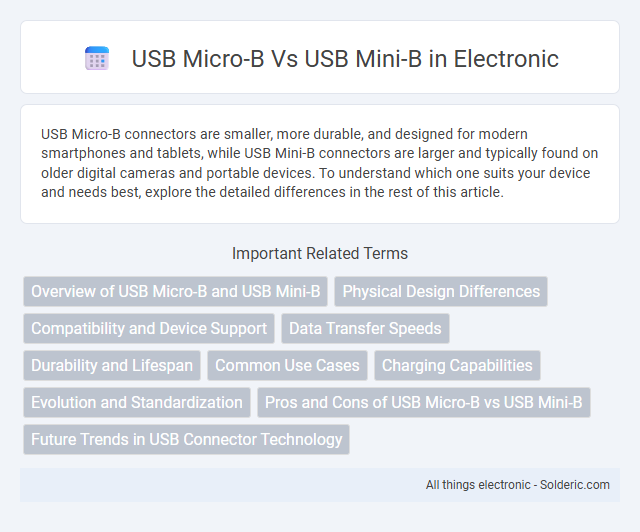USB Micro-B connectors are smaller, more durable, and designed for modern smartphones and tablets, while USB Mini-B connectors are larger and typically found on older digital cameras and portable devices. To understand which one suits your device and needs best, explore the detailed differences in the rest of this article.
Comparison Table
| Feature | USB Micro-B | USB Mini-B |
|---|---|---|
| Introduction Year | 2007 | 2000 |
| Connector Size | Smaller (6.85 x 1.8 mm) | Larger (7.5 x 3 mm) |
| Durability | Up to 10,000 connect cycles | Up to 5,000 connect cycles |
| Device Compatibility | Smartphones, tablets, external drives | Older digital cameras, MP3 players |
| Data Transfer Speed | Supports USB 2.0 (480 Mbps) | Supports USB 2.0 (480 Mbps) |
| Power Delivery | Higher current support (up to 1.8A typical) | Lower current support (generally up to 500mA) |
| Current Usage | Modern devices | Legacy devices |
| Connector Shape | Flat and more durable pattern | Thicker and less resistant |
Overview of USB Micro-B and USB Mini-B
USB Micro-B and USB Mini-B connectors serve different roles in data transfer and charging applications, with USB Micro-B being slimmer and more common in modern smartphones and portable devices due to its compact design supporting USB 2.0 speeds up to 480 Mbps. USB Mini-B connectors, larger and less common today, were widely used in older digital cameras, MP3 players, and similar gadgets, handling similar data rates but with a bulkier form factor. Understanding your device's port type ensures compatibility with cables and chargers designed specifically for either USB Micro-B or USB Mini-B connections.
Physical Design Differences
USB Micro-B connectors are smaller and thinner compared to USB Mini-B, measuring approximately 6.85mm by 1.8mm, making them ideal for compact devices like smartphones and tablets. USB Mini-B connectors are larger, around 7.8mm by 3.1mm, distinguishing themselves with a more robust and thicker design used in older cameras and portable devices. The Micro-B's slim profile features a flatter and more oblong shape, while the Mini-B is bulkier with a trapezoidal form, impacting device compatibility and port durability.
Compatibility and Device Support
USB Micro-B connectors are widely compatible with modern smartphones, tablets, and portable devices due to their smaller size and enhanced durability compared to USB Mini-B connectors. USB Mini-B, being larger, is primarily supported by older devices such as digital cameras and some external hard drives, resulting in limited compatibility with contemporary electronics. Choosing USB Micro-B ensures better device support and future-proofing for Your hardware connections.
Data Transfer Speeds
USB Micro-B connectors typically support USB 2.0 standards with data transfer speeds up to 480 Mbps, making them suitable for fast syncing and charging of modern smartphones and portable devices. USB Mini-B connectors also conform to USB 2.0 but are less common and often found on older devices, providing similar transfer speeds of up to 480 Mbps. The Micro-B's smaller size and widespread adoption in newer technology give it an advantage in versatility while maintaining comparable data transfer performance.
Durability and Lifespan
USB Micro-B connectors offer greater durability and a longer lifespan compared to USB Mini-B due to their more compact design and reinforced construction, which withstands frequent plug and unplug cycles better. USB Micro-B typically supports around 10,000 insertion cycles, whereas USB Mini-B connectors often last for approximately 5,000 cycles. Choosing the Micro-B connector can significantly enhance Your device's reliability and reduce wear over time.
Common Use Cases
USB Micro-B connectors are commonly used in smartphones, external hard drives, and some tablets due to their compact size and durability. USB Mini-B connectors are often found in older digital cameras, MP3 players, and certain GPS devices, reflecting their prevalence before Micro-B became the standard. Your choice between these depends on device compatibility and the need for a smaller, more robust connection in modern electronics.
Charging Capabilities
USB Micro-B connectors support faster charging with higher current ratings up to 3A, enabling quicker power delivery for smartphones and tablets compared to USB Mini-B connectors, which generally handle lower currents around 1.5A. The Micro-B design enhances compatibility with modern USB Battery Charging specifications, ensuring more efficient energy transfer and reducing overall charging time. When selecting a cable or charger, understanding these differences can optimize your device's charging performance.
Evolution and Standardization
USB Micro-B evolved from USB Mini-B to meet the demand for smaller, more durable connectors in mobile devices, supporting USB 2.0 speeds with enhanced insertion cycles of up to 10,000. USB Mini-B, standardized earlier, was designed primarily for digital cameras and older mobile phones but lacked the durability and compactness required by newer technology trends. The transition to Micro-B reflects the broader industry move toward standardized connectors that optimize device form factors while maintaining compatibility across a wide range of peripherals.
Pros and Cons of USB Micro-B vs USB Mini-B
USB Micro-B offers a smaller, more compact design than USB Mini-B, making it ideal for modern smartphones and portable devices, while USB Mini-B is bulkier and less common in current technology. Your choice may depend on device compatibility and durability preferences, as USB Micro-B connectors are generally more fragile but provide faster data transfer speeds. USB Mini-B is known for its robustness and ease of handling but lags in speed and is gradually becoming obsolete.
Future Trends in USB Connector Technology
USB Micro-B connectors, once prevalent in smartphones and portable devices, are being superseded by USB-C due to its reversible design and higher data transfer rates up to 10 Gbps with USB 3.1 standards. USB Mini-B connectors, primarily used in older digital cameras and some external hard drives, are now largely obsolete as industry trends favor the more versatile and power-efficient USB-C interface. Future USB connector technology emphasizes universal compatibility, faster power delivery up to 100W, and support for alternate modes like Thunderbolt 3, phasing out legacy connectors like Micro-B and Mini-B in favor of streamlined, high-performance solutions.
USB Micro-B vs USB Mini-B Infographic

 solderic.com
solderic.com